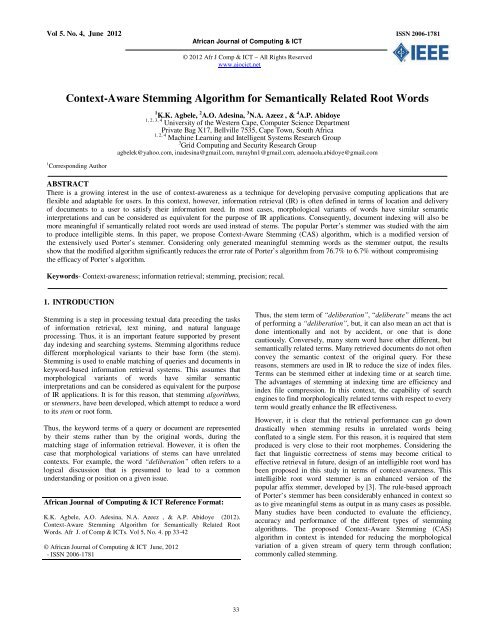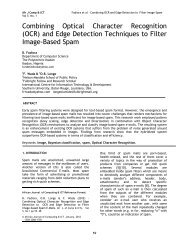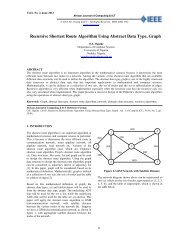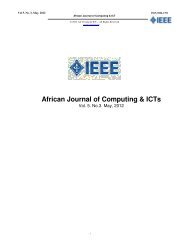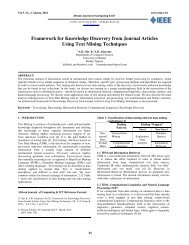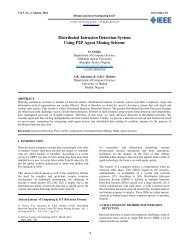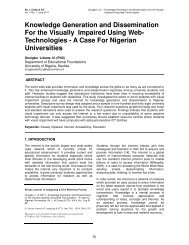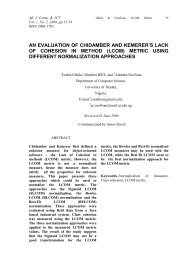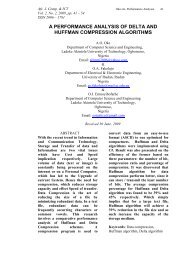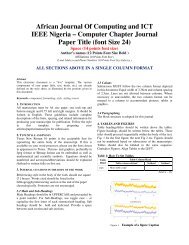Context-Aware Stemming Algorithm for Semantically Related Root ...
Context-Aware Stemming Algorithm for Semantically Related Root ...
Context-Aware Stemming Algorithm for Semantically Related Root ...
You also want an ePaper? Increase the reach of your titles
YUMPU automatically turns print PDFs into web optimized ePapers that Google loves.
Vol 5. No. 4, June 2012 ISSN 2006-1781African Journal of Computing & ICT© 2012 Afr J Comp & ICT – All Rights Reservedwww.ajocict.net2.3 Hybrid Approaches2.3.1. Linguistic Lexical Validation StemmerA study by [5] presented the linguistic lexical validation stemmer.With the intention to decrease stemming errors and increase thestemmer’s accuracy, Krovetz added a dictionary to validate thecorrectness of stems. The Krovetz stemmer per<strong>for</strong>ms a dictionarylookup after the removal of suffixes in a specific order. First, plural<strong>for</strong>ms are converted to singular <strong>for</strong>ms. Next, past tense words areconverted to present. Finally, the “ing” suffix is removed. Besides,the Krovetz stemmer attempts to increase accuracy and robustnessby treating spelling errors and meaningless stems. Spelling errorsand meaningless stems are trans<strong>for</strong>med into the closest word.Although this weak stemmer produced highly accurate results anda huge reduction in stemming errors, the addition of the dictionarylookup increased the complexity of the stemmer. The major andobvious flaw in dictionary-based algorithms is their inability tocope with words, which are not in the lexicon. Also, a lexicon mustbe manually created in advance, which requires significant ef<strong>for</strong>ts.This stemmer does not consistently produce a good recall andprecision per<strong>for</strong>mance.2.3.2. Corpus Based StemmerThis method of stemming was proposed by [9]. The authorssuggested an approach which tries to overcome some of thedrawbacks of Porter stemmer. For example, the words ‘policy’ and‘police’ are conflated though they have a different meaning but thewords ‘index’ and ‘indices’ are not conflated though they have thesame root. Porter stemmer also generates stems which are not realwords. Another problem is that while some stemming algorithmsmay be suitable <strong>for</strong> one corpus, they will produce too many errorson another. Corpus based stemming refers to automaticmodification of conflation classes – words that have resulted in acommon stem, to suit the characteristics of a given text corpususing statistical methods. The basic hypothesis is that word <strong>for</strong>msthat should be conflated <strong>for</strong> a given corpus will co-occur indocuments from that corpus. Using this concept some of the overstemming or under stemming drawbacks are resolved. A study by[9] used statistical measure to determine the significance of word<strong>for</strong>m co-occurrence. The advantage of this method is it canpotentially avoid making conflations that are not appropriate <strong>for</strong> agiven corpus and the result is an actual word and not an incompletestem. The disadvantage is that you need to develop the statisticalmeasure <strong>for</strong> every corpus separately and this increases theprocessing time.2.3.3. <strong>Context</strong> Sensitive StemmerThis is a very interesting method of stemming unlike the usualmethod where stemming is done be<strong>for</strong>e indexing a document, <strong>for</strong> aWeb Search, context sensitive analysis is done using statisticalmodelling on the query side. This method was proposed by [10].Basically <strong>for</strong> the words of the input query, the morphologicalvariants which would be useful <strong>for</strong> the search are predicted be<strong>for</strong>ethe query is submitted to the search engine. This dramaticallyreduces the number of bad expansions, which in turn reduces thecost of additional computation and improves the precision at thesame time. After the predicted word variants from the query havebeen derived, a context sensitive document matching is done <strong>for</strong>these variants.This conservative strategy serves as a safeguard against spuriousstemming, and it turns out to be very important <strong>for</strong> improvingprecision. The advantage of this stemmer is it improves selectiveword expansion on the query side and conservative wordoccurrence matching on the document side. The disadvantage isthe processing time and the complex nature of the stemmer. Therecan be errors in finding the noun phrases in the query and theproximity words.3. THE PORTER’S STEMMING ALGORITHMPorter’s Stemmer [3] uses suffix stripping in English language <strong>for</strong>stemming an input word. The algorithm operates in five steps. Ateach step the input word is trans<strong>for</strong>med based on a list of rules.This stemmer is a linear step algorithm. If a suffix rule getsmatched to a word, then the conditions attached to that rule aretested <strong>for</strong> the resulting stem as if that suffix were removed, as perthe rule. One such condition may be that the number of vowelcharacters followed by a consonant character in the stem must begreater than one, <strong>for</strong> the rule to be applied. Porter’s algorithm doesnot remove a suffix when the stem is too short, i.e. when thenumber of vowel-consonant pairs in a word is zero. The measurem, is used as the decision making variable.Porter algorithm [3] may remove a few characters of the wordbeing stemmed. These characters may be restored, in a later step.Each of the subsequent steps trans<strong>for</strong>ms the partial stem,depending on the rule applicable <strong>for</strong> the given value of m. When arule fires, the suffix is removed and the control moves to the nextstep. The rules in a step are tested successfully until either a rulefrom that step fires and control passes to the next step, or there areno more rules in that step, in which case control moves to the nextstep. This process continues at all the five steps, until the stem isreturned by the stemmer. It is important to note that, in a particularstep, it is sufficient if exactly one rule matches. It then proceeds tothe next step.Our work, instead, focuses on getting reasonable stemmer in termsof context-aware. We highlight some of the drawbacks of Porter’salgorithm, from the perspective of getting understandable stems asoutput. Consider Table 1, which displays two list A and B, with mvalue greater than 0. The condition <strong>for</strong> stripping the suffix – ATEis: (m>0) ATE ‘-‘, an empty right hand side in the rule indicates theremoval of the suffix indicated on the left hand side. Here, thesuffix –ATE is removed from the words of list B, whereas thesuffix E is removed from the words of list A. Complex suffixes areremoved letter by letter in different steps. Thus, the wordgeneralizations is first stripped to get generalization (Step 1); thento generalize (Step 2); then to general (Step 3) and then finally toGENER (Step 4), which is not an understandable word in context.The stemmed word (GENER) is completely out of semanticcontext to the query (GENERAL).35
Vol 5. No. 4, June 2012 ISSN 2006-1781African Journal of Computing & ICT© 2012 Afr J Comp & ICT – All Rights Reservedwww.ajocict.netTable 1: Words and the measure mList ARelateProbateConflatePiratePrelateList BDerivateActivateDemonstrateNecessitateRenovateThe main drawback of this algorithm is that it does not make useof a stem dictionary (lexicon). As per the algorithm, a list ofsuffixes is considered and with each suffix, there is a criterionunder which it may be removed from a word during the <strong>for</strong>mationof a valid stem. The main strengths of this algorithm are that it issmall, fast and reasonably simple. The algorithm feature oftenproduces stems, which are unintelligible. For example, the stemsresult <strong>for</strong> the word anxious is anxiou. This is one of the cases inwhich the suffix has been identified as denoting the plural <strong>for</strong>m ofthe given word. We also get stems like Microscop, Secur and Envi<strong>for</strong> Microscope, Secure and Envy respectively, which are clearlymeaningless. As another example, if Sand and Sander getconflated, so do wand and wander.The error committed here is that the –er part of wander has beentreated as its suffix when in fact it is part of the stem. However, theabsence of a lexicon results in improper conflations and anassociated loss of precision. Converting words like general togener and iteration to iter make it difficult to relate them todictionary entries. It also complicates the process of queryenhancement. We observe that all the approaches to stemmingmentioned not only ignore word meanings, but also operate in theabsence of any lexicon at all. The design goals of theseapproaches seem to be better retrieval and compressionper<strong>for</strong>mance and not the generation of a linguistically correct rootword that is in context. Our main goal is to maximize theproportion of the meaningful stems (words) in the stemmer output<strong>for</strong> a given set of input words, without compromising the otherper<strong>for</strong>mance measures.4. CONTEXT IN INFORMATION RETRIEVALSome definition of context is greatly dependent on the field ofapplications, as shown by the analysis of 150 different definitionsby [11]. In order to use context in developing context awareapplications, the notion of context has to be well understood. Awidely adopted definition of context <strong>for</strong> ubiquitous computing –which is also considered with context-aware IR defines context asany in<strong>for</strong>mation that can be used to characterize the situation of anentity. An entity is a person, place, or object that is consideredrelevant to the interaction between a user and an application,including the user and applications themselves [12].The central aspects in this definition are identity (user), activity(interaction with an application), location and time (as the temporalconstraints of a certain situation). In the same article, Dey definescontext awareness as a system that is context-aware if it usescontext to provide relevant in<strong>for</strong>mation and/or services to the user,where relevancy depends on the user’s task [12].Dey’s definition of context points to potential sources ofcontextual in<strong>for</strong>mation on a generic level. His definition of contextawareness, however, is directly related to the view on context <strong>for</strong>IR taken in this study, which defines an IR task’s context as anyin<strong>for</strong>mation whose change modifies the task’s outcome, <strong>for</strong>instance (stemming reduces any given query term(token), to acommon base). To achieve this goal, we develop an approach <strong>for</strong>context-aware IR that enables a system to provide relevantin<strong>for</strong>mation to the user.Research activities on context-aware IR have increased remarkablyin recent years. The ubiquitous and pervasive computingcommunities have developed numerous approaches toautomatically provide users with in<strong>for</strong>mation and services based ontheir current situation [13] <strong>for</strong> an overview. Existing context-awareapplications range from smart spaces [14] over mobile tour guides[15] to generic prototyping plat<strong>for</strong>ms [16]. <strong>Context</strong> has beensuccessfully employed in a number of ways <strong>for</strong> personalization [17& 18] and to improve retrieval from the Web [19 & 20], fromemail archives [21], from Wikipedia [22], as well as <strong>for</strong> ontologybasedalert services [23], intention recognition [24]. Diverseapproaches based on vector spaces have been proposed to enablecontext-aware in<strong>for</strong>mation retrieval [25]. Maeda identifies contextas one of his laws of simplicity, stating that “what lies in theperiphery of simplicity is definitely not peripheral” [26] transferredto IR, this statement is a clear hint that the context of a retrievaltask needs to be taken into account to make completing the task assimple as possible <strong>for</strong> the user.Lawrence [27] provides an overview of the different strategies tomake Web search context-aware. Yahoo introduced context-awaretools [20] that automatically extend the user’s query by text fromthe Web site the user is currently visiting or from the file she isworking on. Dumitrescu and Santini [28] present a context-awareIR method <strong>for</strong> documents. <strong>Context</strong>s are traces of documents theuser has been working on, which they represent as self-organizingmaps [29]. The authors point out that the advantage of thisapproach is that context does not need to be represented by logicalmeans. Semantic contexts are there<strong>for</strong>e an inevitable requirementto reason about contextual in<strong>for</strong>mation.5. CONTEXT AWARE MODIFICATIONS APPROACH TOPORTER’S ALGORITHMWe examine that the addition of more rules in order to increase theper<strong>for</strong>mance in one part of the vocabulary may cause deprivationof per<strong>for</strong>mance elsewhere. To achieve the goal, after a meticulousanalysis, new suffixes and the context in which they must beremoved have been identified and suitable changes have beenmade to the original Porter’s stemming algorithm. Altogether, 31modifications comprising of 15 additions, 11 replacements and 5deletions have been carried out so that the Porter’s stemmingalgorithm now consists of 65 rules compared to 60 in the originalalgorithm. The modifications were carried out in each step withoutchanging the order suggested by Porter. The Porter’s algorithm is abasic building block <strong>for</strong> the proposed context-aware stemmer. Thesuffix stripping method is rule-based. The following is thesummary of modification steps used by the CAS algorithm.36
Vol 5. No. 4, June 2012 ISSN 2006-1781African Journal of Computing & ICT© 2012 Afr J Comp & ICT – All Rights Reservedwww.ajocict.netStep 1 Rules: The first modified rule US → US, in step 1 of rule 1(Table 2) of the stemmer helps to avoid the stripping of the suffix‘S’ from words like generous, enormous, and anxious and more.Besides, another modification CEED → CEES was carried out onthe same step so that stems given by the stemmer <strong>for</strong> words likesucceed (as success), and exceed (as excess). In order tocompensate <strong>for</strong> the earlier changes <strong>for</strong> words like breed, greed etc.,and a new rule EED → EED was introduced. Next, another ruleIES → Y replaces IES → I in the original Porter’s algorithm totrans<strong>for</strong>m words like Ponies to Poni. The rule IED → Y was addedto trans<strong>for</strong>m words like tried and intensified to try and intensify.Words of the <strong>for</strong>m (*V*) ING → have been modified to (*V*)ING → E. So that the stems <strong>for</strong> words such as scoring → scoreand guiding → guide are stemmed accordingly. The rule (*V*) Y→ I is deleted to trans<strong>for</strong>m words like happy to happi. A new ruleED → E is added to generate stems <strong>for</strong> words like guided (guide),and demonstrated (demonstrate) and more.Step 2 Rules: The modifications in step 2 are described in thefollowing. The rule ANCI → ANCE was modified into ANCY →ANCE. This rule was used to generate stems <strong>for</strong> mendicancy tomedicance. The rule ENCI → ENCE is assumed to be replaced byENCY → ENCY. This rule was used to consider cases likeurgency, frequency, and exigency. The other modification in step 2is ABLI → ABLE that is replaced with ABLY → ABLE togenerate stems <strong>for</strong> words like creditably (as creditable), miserably(as miserable), and notably (as notable) and more. Likewise therule OUSLI → OUS has been modified to OUSLY → OUS.Consequently, callously, seriously, and dubiously are stemmed intocallous, serious, and dubious respectively. Words like sensitivity,captivity, and productivity can be stemmed into sensitive, captive,and productive using rule 14, IVITY → IVE. On modifyingBILITI→BLE as BILITY→BLE, a word like capability isstemmed into capable.Step 3 Rules: A new rule FULLY → FUL was added to stemwords like thankfully to thankful. The rule FUL → removes thesaid suffix from the words completely. For example, thankful isstemmed into thank. The rule LESSLY → LESS stems words likecarelessly to careless and aimlessly to aimless. A word likepossibly is stemmed into possible using BLY → BLE. In this case,there are only two changes in step 3. A new rule LESS → is addedto remove suffix ‘less’ from worthless and priceless. For example,this rule removes the suffix less and generates worth and price. Therule ICITI → IC is modified into ICITY → IC to consider caseslike publicity (public), electricity (electric) and ethnicity (ethnic).Step 4 Rules: Changes in step 4 are described in the following.The rule AL → is modified into AL → E. This rule is to trans<strong>for</strong>magricultural to agriculture, arrival to arrive, and revival to reviverespectively. A new rule IABLE → Y was added to generate stems<strong>for</strong> words like variable (vary) and identifiable (identify). The ruleANCE → is discarded as it results in meaningless stems like vari<strong>for</strong> variance, and appli as appliance etc. The stems <strong>for</strong> wordsending in scopic, such as telescopic (telescope) are obtained byapplying the rule SCOPIC → SCOPE. Removal of IC suffix isdone away with, so that on stemming words such as gyroscopic donot end up on gyroscope. The rule ATE → is discarded to avoidunpredictable results <strong>for</strong> words like activate. The rule FYE → FYwas added to convert words like purifying into their root <strong>for</strong>mpurify. The ‘e’ gets added as a result of a rule in step1 of originalPorter’s stemmer replacing ‘ing’ with ‘e’. The rule TLY → T takescare of words like diligently (diligent) and silently (silent) etcwhich is not done in original Porter’s stemming algorithm.Step 5 Rules: The change in step 5 is the rule which removes thetrailing E from words such as possible and avoidable have beenremoved. This is shown in Table 2. From Table 3, it can be seenthat the modifications to Porter’s stemming algorithm have led tothe generation of better stem words in context. By context, werefer to the circumstances or situation in which a computing tasktakes place.Table 2: Modified RulesStep No. Rule No. Process Porter’s algorithm <strong>Context</strong>-aware stemmer1 1 Add US → US2 Add CEED → CESS3 Add EED → EED4 Modify IES → I IES → Y5 Add IED → Y6 Modify (*V*) ING → (*V*) ING → E7 Delete (*V*) Y → I8 Add ED → E2 9 Modify ANCI → ANCE ANCY → ANCE10 Modify ENCI → ENCE ENCY → ENCY11 Modify ABLI → ABLE ABLY → ABLE12 Modify OUSLI → OUS OUSLY → OUS13 Modify ALITI → AL ALITY → AL14 Modify IVITI → IVE IVITY → IVE15 Modify BILITI → BLE BILITY → BLE16 Add FULLY → FUL17 Add FUL →18 Add LESSLY → LESS19 Add BLY → BLE3 20 Add LESS →21 Modify ICITI → IC ICITY → IC4 22 Modify AL → AL → E23 Add IABLE → Y24 Delete ANCE →25 Add SCOPIC → SCOPE26 Delete IC →27 Delete ATE →28 Add FYE → FY29 Add ALLY → AL30 Add TLY → T5 31 Delete E →37
Vol 5. No. 4, June 2012 ISSN 2006-1781African Journal of Computing & ICT© 2012 Afr J Comp & ICT – All Rights Reservedwww.ajocict.netTable 3: Comparison of stems generated by Porter’s algorithmand CAS algorithmWord (Input) Porter stemmer (Output) CAS (Output)Probate Probat ProbateGladly Gladli GladlyMicroscopic Microscop MicroscopePossibly Possibli PossibleAnxious Anxiou AnxiousIdentifiable Identifi IdentifyThankfully Thankfulli ThankCarelessly Carelessli CarePurifying Purifye PurifyBiblically Biblic BiblicalExceed Excee ExcessCapability Capabiliti CapableFestivity Festiviti FestiveDiligently Diligentli DiligentEthnicity Ethniciti EthnicGuiding Guid GuideHappy Happi HappyDemonstrated Demonstrat DemonstrateCallously Callousli CallousArrival Arriv ArriveEffective Effect EffectFalling Fall FallGeneralization Gener GeneralConditional Condit ConditArchaeology Archaeologi ArchaeologyAppointment Appoint AppointAllowance Allow AllowAdoption Adopt AdoptFormalize Formal FormalAdjustable Adjust Adjust5.1. Our Proposed (CAS) <strong>Algorithm</strong>In this sub-section, we describe our <strong>Context</strong>-<strong>Aware</strong> <strong>Stemming</strong>(CAS) algorithm in detail. CAS algorithm was proposed to lessenthe problems of traditional stemming approach that per<strong>for</strong>ms blindtrans<strong>for</strong>mation of all query terms without considering the contextof the stemmed word <strong>for</strong> effective search with regard to contextawareness. The application flow involves modified rule-basedapproach that will add, replace, and remove query term matchingendings in generating new stem words are illustrated in Figure 1.The modified CAS algorithm uses a list of rules to reduce anygiven query term (token), such as word, to a common base. Therules are applied iteratively by matching a suffix string againstquery term endings. The rule is conditioned so that it may or maynot apply to the query term depending on if the query term hasalready been modified by a previous rule. Each rule specifiesremoving, replacing, or adding characters to the end of the queryterm.The ordering of the rules is important because a rule may bedesigned to act upon changes made by the previous rule. Each rulemay be of arbitrary length and comprises of one or more instancesof the five CAS algorithm rule components. The list of rules isprocessed iteratively until each has had a chance to apply itself tothe query term. When considering the conditioned of the second orgreater instance in a rule, the condition only applies to changesmade to the rule.Within each step, if a suffix rule matched to a word, then theconditions attached to that rule is tested on what would be theresulting stem, if that suffix was removed, in the way defined bythe rule? Once a rule passes its condition and is accepted the ruleapplies and suffix is removed/replaced/added and control moves tothe next step.The CAS will en<strong>for</strong>ce the following boundary conditions. Theinput must be greater than two characters in length and mustcontain at least one vowel and one consonant. The output must begreater than two characters in length. For example, the query word‘filing’. After per<strong>for</strong>ming stemming process, the -ING ending isstripped such that the remaining word contains consonant-vowelconsonant(cvc) pattern i.e. ‘fil’, using step 1 rule 6, we simply add‘e’, so that, ‘fil’ becomes ‘file’. The new stemmed word ‘file’ canbe used in different contexts. It could be a tool used in smoothing,polishing or grinding. Moreover, it could be a folder or box thathouses objects such as papers or cards. In this context, <strong>for</strong> thisreason, the semantic of the original query (filing) has changed.5.2. CAS <strong>Algorithm</strong> Rule Format1. A suffix string (token endings) of 1 or more characters.2. A condition (‘Y’ or ‘N’) indicating if the rule can beapplied to the query term. If the condition is ‘Y’ and thequery term has already been modified by another rule orthis same rule (<strong>for</strong> rule with multiple instances) thenrules cannot be applied to the token.3. The number of characters to remove.4. The string to add to the query term (token) consisting of0 or more characters.5. The number of characters to replace5.3. The CAS <strong>Algorithm</strong> DescriptionIn this section, we describe step by step method of our CASalgorithm as follows:Step 1 Initialization:Input the query termStep 2 Select relevant text ending:Examine the final letters of the query term;Consider the first rule in the relevant ending <strong>for</strong> the input queryterm, and to indicate the first query term among stemmingcandidates.Step 3 Check applicability of rule:If the final letters of the query term do not match the ending rule,output stem, then terminate;if the final letters of the query term and the ending rule matches,then goto 4;if the final letters of the query term and the rule matches, andmatching ending acceptability conditions are not satisfied, thengoto 5;38
Vol 5. No. 4, June 2012 ISSN 2006-1781African Journal of Computing & ICT© 2012 Afr J Comp & ICT – All Rights Reservedwww.ajocict.netStep 4 Apply rule:Delete from the right end of the token the number of charactersspecified by the remove rules;if there is an add string, then add it to the end of the query termspecified by the rule;if there is a replace string, then replace the number specified to theend of the query term;if the condition specified is "no applicable rule" output the stem,then terminate;if the condition specified is "match ending found" then take outputto the next rule to access;Otherwise goto 2.Step 5 Search <strong>for</strong> another rule:Go to the next rule in the rule engine database;if the endings of the query term has changed, output stem, thenterminate;Otherwise goto 3.Step 6 Termination Condition:If matching endings acceptability conditions are satisfied, and thenterminate the stemming processStartInput query term: Examples: car price generalization, conditional appointments, agricultural produce, ethnicity crisis etcAccess rulesRules engineDatabaseAccess stemming rules according to the final letters of the query term.Ending foundRemove endingEnding foundNODo the final letters inthe query term andrule match?YESCan the rule matchbe applied to thequery term?YESNo matchingending foundAccess next RuleNONo matchingending foundReplace/add/removeendingTake the output tothe next rule.YESShould the new stem bestemmed?Apply Rule toproduce new stemMatch foundNONo rule appliesOutput stemStopNo stemming operationFig 1: An Overview of the Proposed CAS Application Flow Architecture39
Vol 5. No. 4, June 2012 ISSN 2006-1781African Journal of Computing & ICT© 2012 Afr J Comp & ICT – All Rights Reservedwww.ajocict.net6. EVALUATION OF RESULTSStemmer evaluations measures have been discussed and evaluatedin literature [30, 31 & 32]. Among the notable criteria <strong>for</strong> judgingstemmer per<strong>for</strong>mance, includes compression per<strong>for</strong>mance,retrieval per<strong>for</strong>mance, and correctness. The extents ofoverstemming and understemming are two other measures thatindicate how incorrect a stemmer can be. Stemmers can also bejudged by their retrieval effectiveness, usually measured by recalland precision, as well as the speed and size. This involvessubstituting different stemmers to see which gives the bestprecision and recall. As a third measure, they can be judged bytheir compression per<strong>for</strong>mance. We use a new evaluation measurein which the ability of the stemmer to output intelligible stems isthe only per<strong>for</strong>mance measure.In this context, we derived meaningful stems from thewords,which imply that the derived stems are linguistically correctwhen compared with most Porter’s stem words that are obviouslymeaningless. We measured the per<strong>for</strong>mance of CAS algorithmoutput by finding the proportion (percentage) of meaningful stemsgenerated by CAS algorithm and comparing that with the output ofthe original Porter’s algorithm. Here we have taken a set of 30English words used by Porter’s algorithm as our working exampleexcluding stop words. Our stem produced meaningful stems in93.3% of the cases on an average while the original Porter’s wassuccessful in 23.3% cases as shown in Figure 2. Consequently, theerror rate of our stemmer is 6.7% against 76.7% due to the Porter’salgorithm. In this context, this improvement has been achievedwithout losing the efficiency of Porter’s algorithm.Fig. 2: Per<strong>for</strong>mance comparison7. CONCLUSIONSSo far, none of the stemming algorithms give 100% output but isgood enough to be applied to the text mining, NLP or IRapplications. The main difference lies in using either a rule-basedapproach or a linguistic one. The popular Porter’s stemmingalgorithm was studied with an aim to generate understandable stemas output, in order to improve the effectiveness of in<strong>for</strong>mationretrieval system.By modifying the rule-based used by Porter’s algorithm, theaccuracy was improved from 23.3% to 93.3% in terms of theproportion of meaningful stems produced by CAS algorithm. Thestemmer was introduced to address the traditional blindtrans<strong>for</strong>mation of all query terms in the context of IR. Thus, theCAS algorithm conveys the semantics context of related terms bythe original query in diverse contexts. In this context, CASalgorithm uses semantic knowledge to reduce stemming errors.The CAS technique can be effectively used in pre-processing40
Vol 5. No. 4, June 2012 ISSN 2006-1781African Journal of Computing & ICT© 2012 Afr J Comp & ICT – All Rights Reservedwww.ajocict.netstages of text summarization and text classification systems in thecontext of in<strong>for</strong>mation retrieval.AcknowledgementThe authors wish to thank and appreciate colleagues within theresearch group <strong>for</strong> their helpful comments and suggestions at theimplementation stage.REFERENCES[1] J. B. Lovins. (1968). Development of a <strong>Stemming</strong> <strong>Algorithm</strong>,Mechanical Translation and Computational Linguistics,vol.11, no. 12, pp: 22-31.[2] J. Dawson. (1974). Suffix removal and word conflation.ALLC Bulletin, vol. 2, no. 3, pp: 33-46.[3] M. Porter (1980). An <strong>Algorithm</strong> <strong>for</strong> Suffix Stripping.Program, vol. 14, no. 3, pp: 130 – 137.[4] D. Paice Chris. (1990). Another Stemmer. ACM SIGIRForum, Volume 24, No. 3, pp: 56-61.[5] R. Krovetz. (1993). Viewing morphology as an inferenceprocess. In Proceedings of the 16th Annual InternationalACM SIGIR Conference on Research and Development inIn<strong>for</strong>mation Retrieval, Pittsburgh, PA, USA – June 27 th –July01, 1993, pp: 191-202.[6] G.E. Freund and P. Willet. (1982), ‘Online identification ofword variants and arbitrary truncation searching using a stringsimilarity measure’. In<strong>for</strong>mation Technology: Research andDevelopment, vol. 1, pp: 177-187.[7] M. Melucci and N. Orio. (2003), A novel method <strong>for</strong> stemmergeneration based on hidden Markov models. Proceedings ofthe 12 th international conference on In<strong>for</strong>mation andknowledge management, New Orleans, LA, USA, Nov 03 –08, pp:131-138.[8] M. Prasenjit, M. Mandar, K. Swapan K. Parui, K. Gobinda,M. Pabitra and D. Kalyankumar. (2007). YASS: Yet anothersuffix stripper. ACM Transactions on In<strong>for</strong>mation Systems.vol. 25, no. 4, article 18.[9] J. Xu, W.B. Croft, (1998). Corpus-based stemming using cooccurrenceof word variants, ACM Transactions onIn<strong>for</strong>mation Systems, vol. 16, no. 1, pp: 61-81.[10] P. Funchun, A. Nawaaz, L. Xin and L. Yumao (2007),<strong>Context</strong> sensitive stemming <strong>for</strong> web search. Proceedings ofthe 30th annual international ACM SIGIR conference onResearch and development in in<strong>for</strong>mation retrievalAmsterdam, July 23 – 27, pp: 639-646.[11] M. Bazire and P. Brézillon. Understanding <strong>Context</strong> Be<strong>for</strong>eUsing It (2005). In A. K. Dey, B. N. Kokinov, D. B. Leake,and R. M. Turner, editors, Modelling and Using <strong>Context</strong>, 5thInternational and Interdisciplinary Conference (CONTEXT2005), volume 3554 of Lecture Notes in Computer Science,pp: 29–40. Springer, July 2005.[12] A. K. Dey. Understanding and Using <strong>Context</strong> (2001).Personal Ubiquitous Computing, vol. 5, no. 1, pp: 4–7.[13] S. Loke. <strong>Context</strong>-<strong>Aware</strong> Pervasive Systems: Architectures <strong>for</strong>a New Breed of Applications. Auerbach Publications, 2006.[14] X. Wang, J. S. Dong, C. Chin, S. Hettiarachchi, and D. Zhang(2004). Semantic Space: An Infrastructure <strong>for</strong> Smart Spaces.IEEE Pervasive Computing, vol. 3, no. 3, pp: 32–39.[15] S. Chou, W. Hsieh, F. Gandon, and N. Sadeh (2005).Semantic Web technologies <strong>for</strong> context-aware museum tourguide applications. In Advanced In<strong>for</strong>mation Networking andApplications, 2005. AINA 2005. 19th InternationalConference on, vol. 2.[16] M. Raento, A. Oulasvirta, R. Petit, and H. Toivonen. <strong>Context</strong>-Phone (2005): A Prototyping Plat<strong>for</strong>m <strong>for</strong> <strong>Context</strong>-<strong>Aware</strong>Mobile Applications. IEEE Pervasive Computing, vol. 4, no.2, pp: 51–59.[17] H. R. Kim and P. K. Chan (2008). Learning implicit userinterest hierarchy <strong>for</strong> context in personalization. AppliedIntelligence, vol. 28, no. 2, pp: 153–166.[18] C. Keßler, M. Raubal, and C. Wosniok (2009). SemanticRules <strong>for</strong> <strong>Context</strong>-<strong>Aware</strong> Geographical In<strong>for</strong>mation Retrieval.In P. Barnaghi, editor, 4th European Conference on SmartSensing and <strong>Context</strong>, EuroSSC 2009, volume 5741 of LectureNotes in Computer Science, pp: 77–92. University of Surrey,Springer.[19] L. Finkelstein, E. Gabrilovich, Y. Matias, E. Rivlin, Z. Solan,G. Wolfman, and E. Ruppin (2001). Placing search in context:the concept revisited. In WWW ’01: Proceedings of the 10thinternational conference onWorldWideWeb, pp: 406–414,New York, NY, USA, ACM Press.[20] R. Kraft, C. C. Chang, F. Maghoul, and R. Kumar (2006).Searching with context. In WWW ’06: Proceedings of the15th international conference onWorldWideWeb, pages 477–486, New York, NY, USA, ACM Press.[21] W. Weerkamp, K. Balog, and M. de Rijke (2009). Using<strong>Context</strong>ual In<strong>for</strong>mation to Improve Search in Email Archives.In Advances in In<strong>for</strong>mation Retrieval. 31st EuropeanConference on In<strong>for</strong>mation Retrieval Conference (ECIR2009), pp: 400–411.[22] A. Ukkonen, C. Castillo, D. Donato, and A. Gionis (2008).Searching the Wikipedia with <strong>Context</strong>ual In<strong>for</strong>mation. InCIKM ’08: Proceedings of the 17th ACM conference onIn<strong>for</strong>mation and knowledge mining, pp: 1351–1352, NewYork, NY, USA, ACM.[23] A. Leonidis, G. Baryannis, X. Fafoutis, M. Korozi, N.Gazoni, M. Dimitriou, M. Koutsogiannaki, A. Boutsika, M.Papadakis, H. Papagiannakis, G. Tesseris, E. Voskakis, A.Bikakis, and G. Antoniou (2009). AlertMe: A Semanticsbased<strong>Context</strong>-<strong>Aware</strong> Notification System. In 33rd AnnualIEEE International Computer Software and ApplicationsConference, pp: 200–205. IEEE.[24] P. Kiefer and C. Schlieder (2007). Exploring contextsensitivityin spatial intention recognition. In Proceedings ofthe Workshop on Behavior Monitoring and Interpretation(BMI’07), pp: 102–116.[25] M. Melucci. A basis <strong>for</strong> in<strong>for</strong>mation retrieval in context(2008). ACM Trans on Info Sys, Vol. 26, No. 3, pp: 1–41.41
Vol 5. No. 4, June 2012 ISSN 2006-1781African Journal of Computing & ICT© 2012 Afr J Comp & ICT – All Rights Reservedwww.ajocict.net[26] J. Maeda. The Laws of Simplicity (Simplicity: Design,Technology, Business, Life). The MIT Press, August 2006.[27] S. Lawrence. <strong>Context</strong> in Web Search (2000). IEEE DataEngineering Bulletin, vol. 23, no.3, pp: 25–32.[28] A. Dumitrescu and S. Santini. Think locally, search globally;context based in<strong>for</strong>mation retrieval (2009). In InternationalConference on Semantic Computing, pages 396–401, LosAlamitos, CA, USA, 2009. IEEE Computer Society.[29] T. Kohonen. Self-Organizing Maps. Springer, 3rd edition,2000.[30] J. B. Lovins (1971). Error evaluation <strong>for</strong> stemming algorithmsas clustering algorithms. Journal America Social ofIn<strong>for</strong>mation Science, vol. 22, pp: 28-40.[31] C. D. Paice (1994). An Evaluation Methods <strong>for</strong> <strong>Stemming</strong><strong>Algorithm</strong>s in Croft, W. B. and C. J. Van Rijsbergen, (Eds.).Proceedings of the 17 th ACM SIGIR Conference, Dublin, July3-6, pp: 42-50.W. Kraaij and R. Pohlmann (1996). Viewingstemming as recall enhancement. Proceedings of the 17 thACM SIGIR Conference, Zurich, August 18-22, pp: 40-48Authors’ BriefsKehinde Kayode AGBELE is a Lecturerat Department of Mathematical Sciences(Computer Science Option), EKSU, Ado-Ekiti, Nigeria. AGBELE received B.Sc(Hons) degree in Computer Science fromOndo State University (now Ekiti StateUniversity), Ado in 1997, and M.Techdegree in Computer Science from the Federal University ofTechnology, Akure, in 2005. Currently, AGBELE is a DoctoralResearch student at University of the Western Cape, ComputerScience Department (Machine Learning and Intelligent SystemsResearch Group), Cape Town, South Africa. His research interestsinclude In<strong>for</strong>mation Retrieval, Data Mining, Text Mining, WebSearch Engine, Agent Technology, Pattern Classification andClustering, Ubiquitous Healthcare, ICTs & Applications. He canbe reached by phone on +27789345755 and through E-mail atagbelek@yahoo.com.Ademola Olusola ADESINA, a lecturer of Computer Science inLagos State University (LASU), obtained his First Degree inComputer Science from Ogun State University (now OlabisiOnabanjo University), Ago-Iwoye and Masters Degree inComputer Science from the University of Ibadan, Nigeria. He ispresently a doctoral student at the University of the Western Cape,Department of Computer Science (Machine Learning andIntelligent Systems Research Group), Cape Town, South Africa.His research interests are in Mobile computing, Text Processing,Agent Technology, In<strong>for</strong>mation Retrieval, Web Search and Mobilesecurity. Email: inadesina@gmail.comAzeez Nureni Ayofe graduates withB.Sc. (Hons) degree in ComputerScience with Second Class (Hons.)Upper Division, from the FederalUniversity of Technology, Akure(FUTA), Ondo State, Nigeria in 2004.He proceeded in 2006 to the Universityof Ibadan, Oyo State, Nigeria, aftercompleting his National Youth Service Corps (NYSC)programme, <strong>for</strong> his Masters Degree programme in ComputerScience which he successfully completed in 2008. He is currentlya PhD research student in Computer Science at the University ofthe Western Cape, South Africa. He was a lecturer in theDepartments of Computer Science of Crescent University,Abeokuta, Ogun State, Nigeria and the Fountain University,Osogbo, Osun State, Nigeria between 2008 - 2010. His areas ofresearch include security and privacy; Grid and Cloud computing,knowledge representations and Computer Education &Applications. He can be contacted on +277 3 899 1735;nurayhn@yahoo.ca; and 3008814@uwc.ac.za.Abidoye Ademola Philip received B.Techdegree from Federal University ofTechnology Akure, Ondo State, Nigeria in2001. He went further <strong>for</strong> his master’sdegree (M.Sc.) in Computer Science fromUniversity of Ibadan, Oyo State, Nigeriaand completed it in 2006. He is presently aPhD student in Computer Science atUniversity of the Western Cape, Cape Town South Africa. He isworking as a Lecturer in the Department of Computer Science,Lagos State University, Ojo Nigeria. He has attended both localand international conferences, written many papers published inreputable international journals. His research areas includewireless sensor network, energy optimization, security, and mobilehealth. He can be contacted through Email:ademaola.abidoye@gmail.com42


